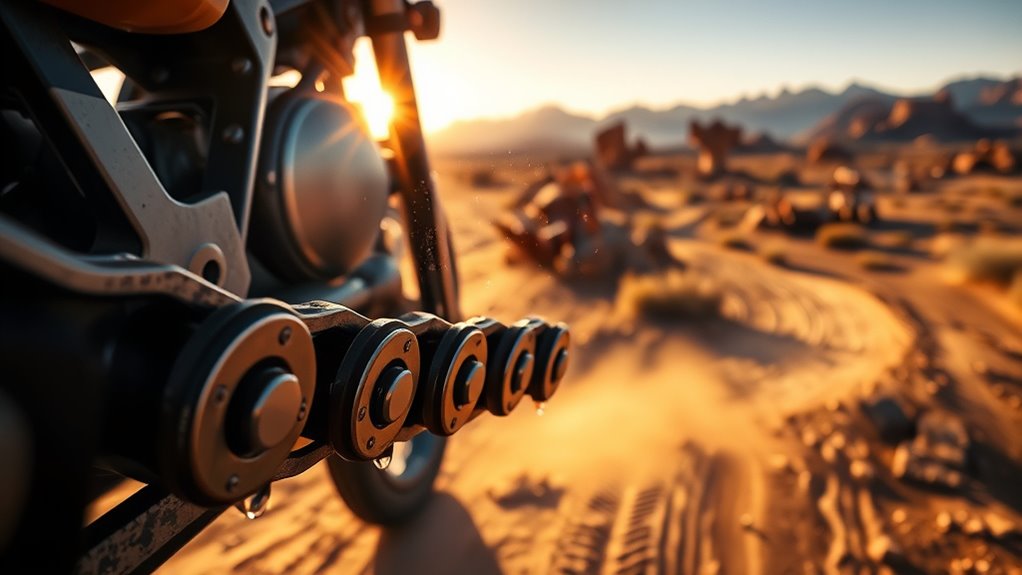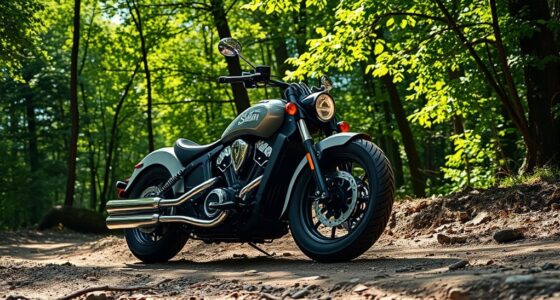Many myths about chain lubrication for desert riding can lead you astray. Over-lubricating doesn’t offer better protection; it just attracts dirt and causes faster wear. Not all lubricants are equal—choose those designed for harsh conditions. Thickness isn’t as critical as proper film formation, and regular cleaning remains essential, regardless of lubricant type. Water-resistant lubes are ideal for sandy environments. Keep these facts in mind, and you’ll be better equipped—continue exploring to learn more.
Key Takeaways
- Using too much lubricant attracts dirt and accelerates wear; apply just enough to coat the chain links.
- Thick lubricants are not always better; proper formulation for heat and dust resistance is more important.
- Regular cleaning is essential regardless of water-resistant lubes to prevent dirt buildup and maintain chain performance.
- Over-lubrication traps debris, increasing friction and chain wear; targeted application helps extend chain life.
- Choosing lubricants designed for harsh desert conditions ensures better protection, reduced dirt attraction, and longer chain durability.
Excess Lubrication Doesn’t Equal Better Protection

Many people believe that applying more lubricant will provide better protection for their bike chain, but this isn’t true. Over-lubricating can actually do more harm than good. Excess lubricant attracts dirt, dust, and debris, which then stick to the chain and accelerate wear. It can also create a sticky, gunky buildup that hampers smooth operation. Instead of protecting, too much lube can cause the chain to become sluggish and difficult to maintain. Proper lubrication means applying just enough to coat each link without excess. After applying, wipe off any visible excess to prevent dirt from sticking. Remember, a little goes a long way. Focus on the quality and proper application of lubricant to keep your chain running smoothly and last longer in desert conditions. Additionally, using appropriate lubricants designed for dusty environments can further extend your chain’s lifespan.
All Chain Lubes Are Created Equal
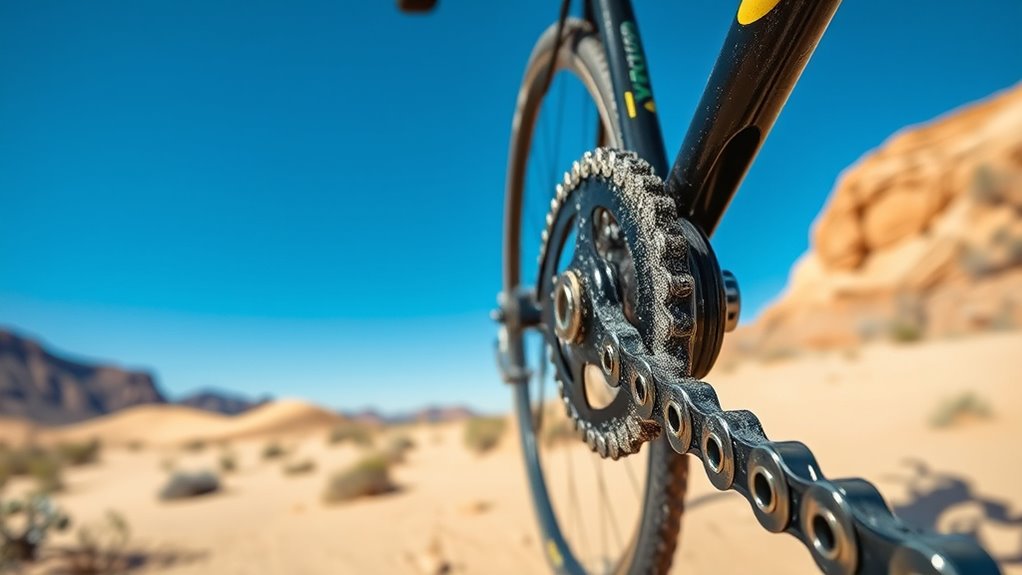
Not all chain lubricants deliver the same level of performance or protection. Some lubricants are designed for everyday riding, offering basic protection against rust and wear, while others are formulated specifically for harsh desert conditions. You might think any lube will do, but choosing the wrong type can lead to increased wear, dirt buildup, and decreased efficiency. For desert riding, you need a lubricant that sticks well, resists wash-off by dust and water, and reduces friction. Not all products provide these benefits equally. Using a generic or low-quality lube can cause more harm than good. Do your homework and select a lubricant tailored for extreme conditions. It’s also helpful to understand the importance of curiosity in making informed choices about gear and maintenance. It’ll save you time, money, and frustration in the long run.
Lubricant Thickness Doesn’t Matter in the Desert
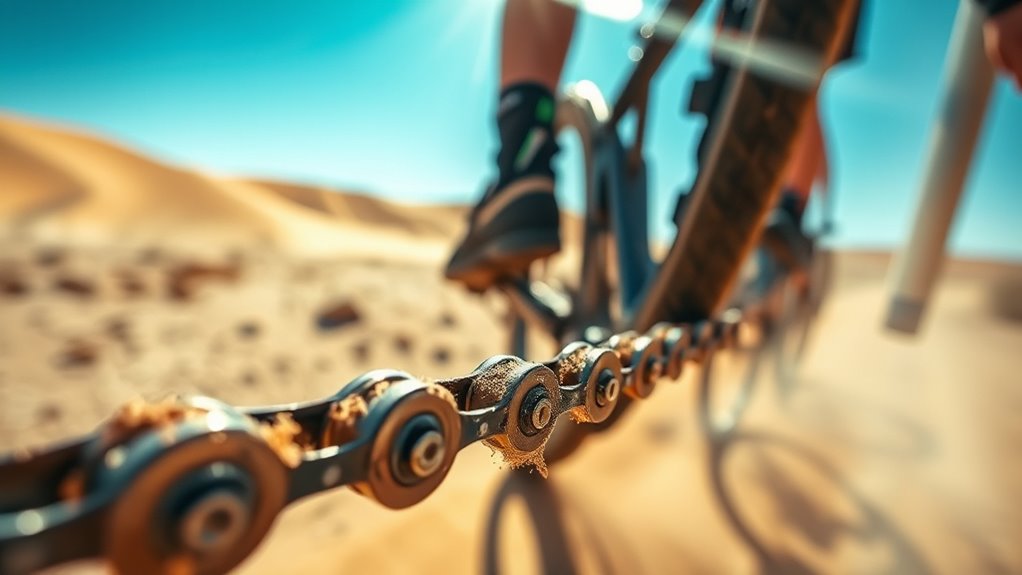
Many believe that thin lubricants work fine in desert conditions, but inadequate film formation can leave your chain vulnerable to wear. Heat increases viscosity, so a lubricant that’s too thin may not provide lasting protection. Choosing the right thickness helps maintain proper film and resists breakdown in high temperatures. Additionally, understanding how Real Couples manage their relationships can offer insights into maintaining harmony under stressful conditions.
Thin Oil Risks
While it might seem that thinner oil is better suited for desert conditions due to high temperatures, relying on a lightweight lubricant can actually pose significant risks. Thin oils tend to flow easily, which might sound ideal, but they can’t create a sufficient protective film on your chain. This leads to increased metal-to-metal contact, accelerating wear and potential damage. In the desert’s harsh environment, debris and dust can quickly infiltrate poorly lubricated chains, causing abrasion and corrosion. Using oil that’s too thin also means it may evaporate or break down faster under intense heat, leaving your chain vulnerable. Instead, choose a lubricant with the right viscosity that maintains a robust film, providing consistent protection against the desert’s extreme conditions.
Proper Film Formation
In desert conditions, the thickness of your lubricant isn’t the main factor in protecting your chain. Instead, focus on proper film formation, which ensures a thin, even layer coats all moving parts. A good lubricant creates a durable film that adheres well, resisting washout from dust and sand. Thick lubricants aren’t necessarily better; they can attract dirt and cause buildup. Proper film formation depends on applying the right amount of lubricant and ensuring it penetrates into chain links and rollers. When done right, this film reduces metal-to-metal contact, minimizes wear, and keeps your chain running smoothly. Remember, it’s not about how thick the lubricant is but how well it forms a protective, consistent coating that lasts under harsh desert conditions. Effective film formation is essential for maintaining chain performance in challenging environments.
Heat and Viscosity
In desert conditions, the temperature fluctuations have a greater impact on your chain’s performance than the lubricant’s thickness. When riding in extreme heat, your chain heats up quickly, causing the lubricant to thin out regardless of its viscosity rating. Conversely, in cooler mornings, the lubricant remains thicker, but this doesn’t mean it’s better or worse—just different. Viscosity isn’t the only factor; what matters most is using a lubricant designed for high temperatures and rapid heat cycling. Many riders believe thicker oils are better for desert riding, but in reality, a properly formulated lubricant that maintains film strength at elevated temperatures is key. Focus on selecting a lubricant that resists thinning out under heat, rather than obsessing over viscosity alone. Additionally, choosing a lubricant with temperature stability ensures consistent protection regardless of the fluctuating desert temperatures.
Cleaning the Chain Is Optional With Proper Lube

When you use the right lubricant, it sticks to your chain and keeps out dirt. This means dirt doesn’t easily mix with the lube or cause wear. So, cleaning your chain often might not be as essential as you think, as long as you keep it properly lubricated. Additionally, choosing a lubricant with proper exfoliating properties can help in maintaining cleaner and healthier skin around your bike components.
Lubricant Adheres to Chain
Many believe that if you apply enough lubricant, it will stick to the chain and keep it protected without requiring regular cleaning. However, this isn’t entirely true. Proper lubrication helps reduce friction and prevents rust, but it doesn’t create a permanent bond that lasts forever. Dirt, dust, and debris can still stick to the lubricant, forming a gritty layer that accelerates wear. If you skip cleaning, contaminants can embed into the lubricant, leading to increased friction and potential damage. To guarantee ideal chain performance, you should clean the chain regularly, then reapply lubricant. This process keeps dirt from building up and ensures the lubricant adheres effectively. Proper maintenance involves both cleaning and lubricating, rather than relying solely on the initial application to do all the work. Additionally, understanding how lubricant adherence works can help you choose the right product for optimal protection.
Dirt Doesn’t Harm Lubricant
Some believe that as long as your chain is properly lubricated, dirt and debris won’t cause harm. However, this isn’t true. Even with good lubrication, dirt can mix with the oil, forming an abrasive paste that accelerates wear. Over time, tiny particles embed in the chain’s rollers and pins, leading to increased friction and potential damage. Proper lubrication helps reduce metal-on-metal contact, but it doesn’t eliminate the abrasive effects of dirt. Neglecting regular cleaning allows dirt buildup, which can compromise the chain’s longevity and performance. Instead of skipping cleaning, focus on maintaining both a clean chain and proper lubrication. This combined approach ensures your chain stays smooth, durable, and ready for tough desert riding conditions. Additionally, understanding contrast ratio can help you evaluate how well your chain and sprockets perform under varying conditions, ensuring optimal efficiency and durability.
More Frequent Lubrication Prevents Wear
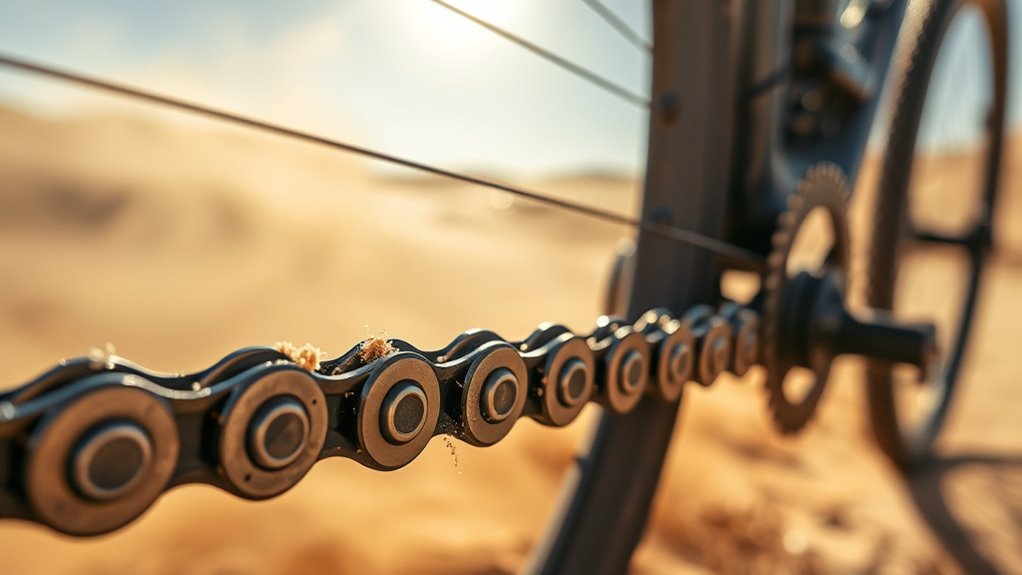
While it might seem intuitive that more frequent lubrication prevents wear, the reality is more nuanced. Over-lubricating can actually attract dirt and debris, which increases abrasion and accelerates chain wear. Instead, focus on applying the right amount of lubricant at appropriate intervals—typically after riding in dusty or sandy conditions. Proper lubrication forms a thin film that reduces metal-on-metal contact, preventing premature wear. However, excessive lubrication can cause buildup, attracting dirt and trapping grit that wears down your chain faster. Regularly inspecting your chain and applying lubricant as needed ensures ideal protection without overdoing it. Remember, the goal isn’t just frequent lubrication, but smart, targeted lubrication that maintains chain integrity without inviting unnecessary dirt. Using appropriate lubrication techniques can further optimize chain longevity and performance.
Water-Resistant Lubes Are the Best Choice for Sandy Conditions
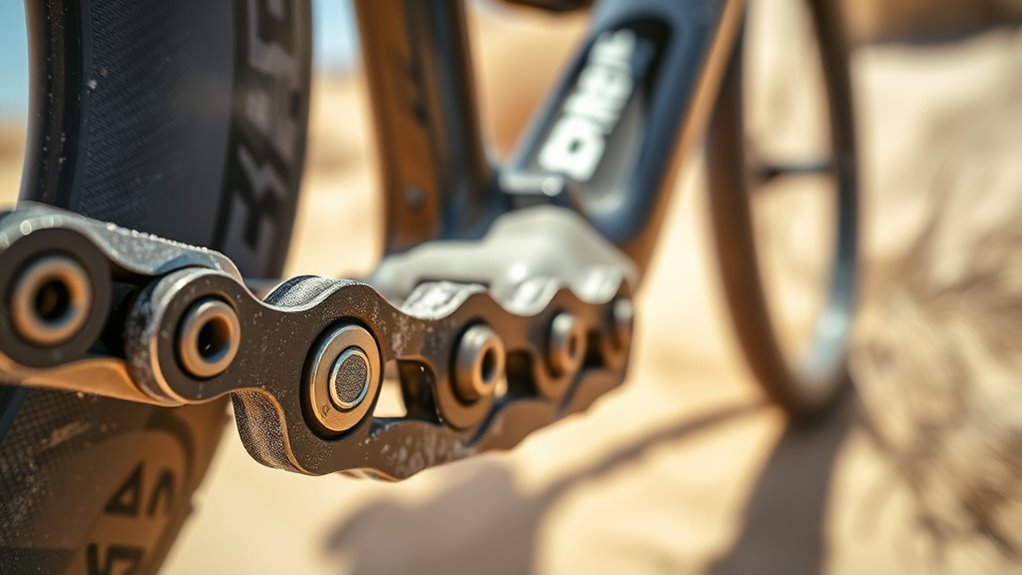
When riding in sandy conditions, using water-resistant lubricants can markedly extend your chain’s lifespan. Sand and dust are abrasive, and water-resistant lubes help prevent these particles from sticking to your chain, reducing wear and corrosion. Unlike standard lubes that wash away easily, water-resistant options stay put even when exposed to moisture or sweat. This ensures your chain remains well-lubricated, minimizing friction and preventing rust. Applying a water-resistant lube before your ride creates a protective barrier that keeps dirt and water at bay. Regular application is important, but choosing the right lubricant significantly improves your chain’s durability and performance. Keep in mind, though, that these lubes aren’t a cure-all; regular cleaning is still essential. But for sandy environments, water-resistant lubricants are your best bet to keep your chain running smoothly and lasting longer.
Frequently Asked Questions
How Often Should I Lubricate My Desert Motorcycle Chain?
You should lubricate your desert motorcycle chain regularly, ideally after every ride or every 100-200 miles, especially in dusty conditions. Keep an eye on the chain’s tension and cleanliness, and apply lubricant when it appears dry or dirty. Proper lubrication prevents rust, reduces wear, and guarantees smooth operation. Remember, consistent maintenance helps your bike perform better and extends the life of your chain, so don’t skip this essential step.
Can I Use Motor Oil as Chain Lubricant in the Desert?
Did you know that using motor oil on your chain can reduce its lifespan by up to 50%? It might seem convenient, but motor oil isn’t designed for chain lubrication, especially in the desert’s harsh conditions. Instead, use a proper chain lube to withstand dirt, sand, and heat. This keeps your chain running smoothly and lasts much longer, saving you time and money on repairs.
What Signs Indicate My Chain Needs Lubrication?
When your chain needs lubrication, you’ll notice it feels dry or gritty when you run your fingers over it. You might also see visible rust or dirt buildup, and the chain could sound noisier during rides. If the chain looks dull or stiff, it’s time to apply lubricant. Regularly check your chain’s condition, especially after riding in dusty or sandy conditions, to keep it running smoothly and prevent premature wear.
Does Chain Lubrication Affect Bike Performance in Sandy Conditions?
Think of your bike chain as a dancer’s shoes—without proper care, performance suffers. In sandy conditions, lubrication acts like a protective barrier, reducing friction and preventing dirt buildup. When you keep your chain well-lubricated, it rolls smoothly over rough terrain, minimizing wear and energy loss. Skipping lubrication turns your ride into a stumble, decreasing speed and increasing maintenance needs in harsh desert environments.
Are There Eco-Friendly Lubricants Suitable for Desert Riding?
You’re wondering if eco-friendly lubricants work well for desert riding. The good news is, many biodegradable options are designed specifically for tough, sandy conditions. Look for products labeled as eco-friendly and suitable for off-road use, as they often contain fewer harmful chemicals and won’t damage the environment. These lubricants provide good protection and reduce environmental impact, making them a smart choice for desert riders who want to stay eco-conscious.
Conclusion
Now that you know these lubrication myths are just that—myths—you’re better equipped to care for your desert bike. Over-lubricating or relying solely on water-resistant lubes won’t keep your chain in top shape if you skip proper cleaning and maintenance. Isn’t it worth investing a little time to ensure your chain runs smoothly and lasts longer? Remember, smarter care beats misconceptions every time—so stay informed and ride confidently through those dunes.
